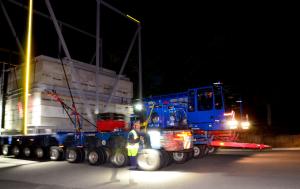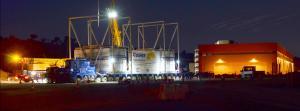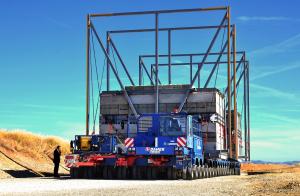A successful journey ... to be replicated 200 times
After successfully navigating the ITER Itinerary for four consecutive nights, the test convoy reaches the ITER site.

4:45 a.m., Friday 20 September 2013: The 800-ton trailer rolls to a slow stop on the ITER site in the early morning hours. Under the light of the full moon, those gathered around the enormous 352-wheel vehicle—46 metres long, 9 metres wide and 11 metres high—break into spontaneous applause. The test operation for the ITER Itinerary can be considered a complete success.
Four nights earlier on the banks of the Étang de Berre, a small inland body of water west of Marseille near the Mediterranean Sea, a long procession of men and machinery had started off at measured pace. The goal: to carry out a full-size test of the transport of an exceptionally-sized ITER component. At critical points along the 104 kilometre ITER Itinerary from Berre to the ITER site—for example bridges, highway crossings, villages—measurements were taken to assess the stress imposed on the structures by the exceptional weight and dimensions of the test convoy.
Over one hundred people participated in the test operation. It was the culmination of years of preparation, from the large-scale public works carried out by France to ready the Itinerary for ITER loads, to the administrative machinery set into place to plan for every contingency. Before the test convoy could take place, an enormous technical, administrative and regulatory machine had to be fine-tuned. Organizing the transport of an ITER component is infinitely more complex than transporting a container or a load of wood ...
When, in 2005, the ITER partners chose a site near the French research installation CEA in southern France over a site proposed by Japan (Rokkasho-Mura, on the Pacific Ocean), they knew they would have one major obstacle to overcome. With a location fully 100 kilometres from the nearest coast, how would it be possible to transport the large ITER components shipped to the Project from factories all over the world with every guarantee of safety for the material and security for local residents?
The choice was soon made to create a dedicated Itinerary by carrying out work to adapt routes, reinforce bridges and, when necessary, create deviations. The responsibility fell to France as Host to the ITER Project. Between 2006 and 2010, the technical studies and necessary adaptations were carried out, financed in part by the local département (Conseil général des Bouches-du-Rhône) and in part by the French state.
As they travel the 104 kilometres of the ITER Itinerary, the ITER convoys will cross 16 villages, negotiate 16 roundabouts, cut across the motorway in three locations and cross 35 bridges. The Itinerary is the ITER "lifeline," permitting the most exceptionally sized ITER components to be transported to the assembly workshops of the ITER site from their point of disembarkation on the Mediterranean Sea.
The test operation held from 16 to 20 December was the occasion for the public, crowded along the roadside during the four nights of the maiden convoy, to get a sense of the size and weight of the future ITER loads. Not every load will be as impressive as this first, of course—of 230 the convoys that will begin to arrive at ITER starting in the summer of 2014, only 30 will replicate one of the exceptional dimensions of the test convoy (weight, height, width or length), without cumulating them all.
An ITER convoy will not just be a motorized vehicle and its squadron of police escort and technical vehicles snaking along the cordoned-off Itinerary. Several dozen kilometres of deviations will have to be organized; traffic on the motorway will be halted in the middle of the night; hundreds of road signs will be removed, then replaced; and unexpected situations will have to be managed as they arise.
All of these operations were "practiced" from 16-20 September 2013 during the full-scale ITER Itinerary test convoy operation. A second test, this time dedicated exclusively to logistics and organization, will take place in April 2014.
All participants—Agence Iter France, the logistics service provider Daher, the European Domestic Agency for ITER, the French authorities (prefecture, gendarmerie), and ITER Organization—can be congratulated on a job well done. A truly successful maiden journey that must be replicated more than 200 times in the years to come.



